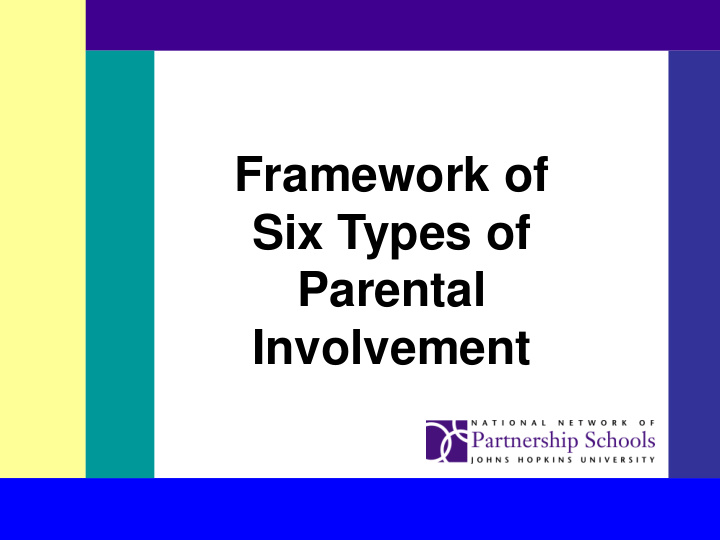



Framework of Six Types of Parental Involvement
Theoretical Model OVERLAPPING SPHERES OF INFLUENCE OF FAMILY, SCHOOL, AND COMMUNITY ON CHILDREN’S LEARNING External Structure Force C Force B Experience, Experience, Philosophy, Philosophy, Practices Practices of School of Family Force D Experience, Philosophy, Practices of Community Force A Time/Age/Grade Level See Handbook chapters 4 and 5 for the Internal structure of interpersonal connections in this model.
THE KEYS TO SUCCESSFUL SCHOOL-FAMILY-COMMUNITY PARTNERSHIPS EPSTEIN’S SIX TYPES OF INVOLVEMENT PARENTING: Assist families in understanding child and adolescent Type 1 development, and in setting home conditions that support children as students at each age and grade level. Assist schools in understanding families. COMMUNICATING: Communicate with families about school programs and student progress through effective school-to-home Type 2 and home-to-school communications. VOLUNTEERING: Improve recruitment, training, work, and Type 3 schedules to involve families as volunteers and audiences at school or in other locations to support students and school programs. LEARNING AT HOME: Involve families with their children in Type 4 learning activities at home, including homework, other curriculum- related activities, and individual course and program decisions. DECISION MAKING: Include families as participants in school decisions, governance, and advocacy through PTA/PTO, school Type 5 councils, committees, action teams, and other parent organizations. COLLABORATING WITH COMMUNITY: Coordinate resources and services for students, families, and the school with businesses, Type 6 agencies, and other groups, and provide services to the community.
Type 1 PARENTING Basic Responsibilities of Families Housing, health, nutrition, clothing, safety Understand child and adolescent development and parenting skills for all age levels Home conditions that support children as students at all grade levels Information and activities to help schools understand children and families
Type 2 COMMUNICATING Basic Responsibilities of Schools SCHOOL-TO-HOME Memos, notices, report cards, conferences, newsletters, phone calls, computerized messages, e-mails, Web sites Information to help families • Understand school programs and children’s progress • Understand state tests, report cards, and other assessments • Choose or change schools • Choose or change courses, placements, programs, and activities HOME-TO-SCHOOL Two-way channels of communication for questions, suggestions, and interactions
Type 3 Volunteering Recruit and Organize Parent Help and Support School and classroom volunteer programs to help teachers, administrators, students and other parents Parent room or family center for volunteer work, meetings, resources for families Annual postcard survey to identify all available talents, times and locations of volunteers Class parent, telephone tree, or other structures to provide all families with needed information Parent patrols or other activities to aid safety and operation of school programs
Type 4 LEARNING AT HOME Involvement in Academic Activities INFORMATION FOR FAMILIES ON… How to help at home with homework Required skills to pass each subject Curriculum-related decisions by and for the student Development of students’ other skills and talents
Type 5 DECISION MAKING Participation and Leadership School Council or School Improvement Team Action Team for Partnerships PTA/PTO membership, participation, leadership, representation Title I advisory and other school or district committees Independent advisory and advocacy groups
Type 6 COLLABORATING WITH THE COMMUNITY Community contributes to schools, students, and families • Business partners • Cultural and recreational groups • Health services • Senior citizen organizations • Faith-based organizations • Government and military agencies • Other groups, agencies, and organizations Schools, students, and families to contribute to the community • Service learning and other special projects
An Inventory of Present Practices of School, Family, and Community Partnerships Your TABLE will be assigned ONE TYPE of involvement. 1. LOOK: With a partner, look down the list of activities for the TYPE of involvement that you were assigned. 2. CHECK: Check the activities conducted in your school (or schools you supervise or assist) and the grade levels that conduct each activity. 3. REFLECT: What comes to mind as you think about the activities for that TYPE of involvement? 4. CONTINUE: If you finish before time is up, select another TYPE of involvement to review.
Taking it Back!
Recommend
More recommend